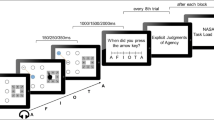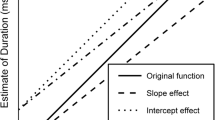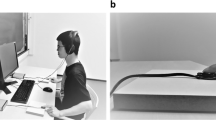Abstract
Temporal binding (TB) refers to a subjective contraction of the time that elapses between an action and a delayed sensory consequence of it. The TB effect has been demonstrated primarily in tasks in which a key press triggers a tone after a short delay and in which participants judge the timing of one or both of these events relative to a visual reference (e.g., a rotating clock hand). In the present Experiments 1 and 2, musicians listened instead to an auditory “clock” (a metronome) and occasionally made a tap that triggered a delayed tone. The task was to judge whether that test tone fell before, on, or after the midpoint of the interval between two metronome tones. In a passive control condition, participants judged test tones but did not tap. The hypothesis was that the test tone would be perceived as occurring earlier in the active than in the passive condition. However, there was no difference in perceptual judgments. Experiment 3 used a visual metronome as the reference but again obtained negative results, despite greater uncertainty of judgments. It is suggested that TB of action consequences to actions does not occur when the reference signal is rhythmic because such a context enables participants (musicians, at least) to perceive and judge the actual time of occurrence of the action-triggered tone.





Similar content being viewed by others
Notes
In the literature, actions are usually said to produce “effects”. The term “consequence” is preferred here, to avoid confusion with effects of experimental variables and with the temporal binding effect.
I am grateful to Yi-Huang (Jasmine) Su for alerting me to the second possibility.
References
Buehner MJ, Humphreys GR (2009) Causal binding of actions to their effects. Psychol Sci 20:1221–1228
Cravo AM, Claessens PME, Baldo MVC (2009) Voluntary action and causality in temporal binding. Exp Brain Res 199:95–99
Cravo AM, Claessens PME, Baldo MVC (2011) The relation between action, predictability and temporal contiguity in temporal binding. Acta Psychol 136:157–166
Eagleman DM, Holcombe AO (2002) Causality and the perception of time. Trends Cogn Sci 6:323–325
Ebert JP, Wegner DM (2010) Time warp: authorship shapes the perceived timing of actions and events. Conscious Cogn 19:481–489
Engbert K, Wohlschläger A (2007) Intentions and expectations in temporal binding. Conscious Cogn 16:255–264
Engbert K, Wohlschläger A, Haggard P (2008) Who is causing what? The sense of agency is relational and efferent-triggered. Cognition 107:693–704
Grondin S (1993) Duration discrimination of empty and filled intervals marked by auditory and visual signals. Percept Psychophys 54:383–394
Haggard P, Aschersleben G, Gehrke J, Prinz W (2002a) Action, binding, and awareness. In: Prinz W, Hommel B (eds) Common mechanisms in perception and action: Attention and Performance XIX. Oxford University Press, Oxford, pp 268–285
Haggard P, Clark S, Kalogeras J (2002b) Voluntary action and conscious awareness. Nat Neurosci 5:382–385
Haggard P, Martin F, Taylor-Clarke M, Jeannerod M, Franck N (2003) Awareness of action in schizophrenia. NeuroReport 14:1081–1085
Hartcher-O’Brien J, Alais D (2011) Temporal ventriloquism in a purely temporal context. J Exp Psychol Hum Percept Perform (online first). doi:10.1037/a0024234
Hommel B, Müsseler J, Aschersleben G, Prinz W (2001) The theory of event coding (TEC): a framework for perception and action planning. Behav Brain Sci 24:849–937
Humphreys GR, Buehner MJ (2009) Magnitude estimation reveals temporal binding at super-second intervals. J Exp Psychol Hum Percept Perform 35:1542–1549
Humphreys GR, Buehner MJ (2010) Temporal binding of action and effect in interval reproduction. Exp Brain Res 203:465–470
Huron D, Royal M (1996) What is melodic accent? Converging evidence from musical practice. Music Percept 13:489–516
Keller PE, Wascher E, Prinz W, Waszak F, Koch I, Rosenbaum DA (2006) Differences between intention-based and stimulus-based actions. J Psychophysiol 20:9–20
Large EW (2008) Resonating to musical rhythm: theory and experiment. In: Grondin S (ed) Psychology of time. Emerald, Bingley, pp 189–232
Libet B, Gleason CA, Wright EW, Pearl DK (1983) Time of conscious intention to act in relation to onset of cerebral activity (readiness-potential): the unconscious initiation of a freely voluntary act. Brain 106:623–642
Moore J, Haggard P (2008) Awareness of action: inference and prediction. Conscious Cogn 17:136–144
Moore JW, Lagnado D, Deal DC, Haggard P (2009) Feelings of control: contingency determines experience of action. Cognition 110:279–283
Mueller VA, Brass M, Waszak F, Prinz W (2007) The role of the preSMA and the rostral cingulated zone in internally selected actions. NeuroImage 37:1354–1361
Obhi SS, Hall P (2011a) Sense of agency and intentional binding in joint action. Exp Brain Res 211:655–662
Obhi SS, Hall P (2011b) Sense of agency in joint action: influence of human and computer co-actors. Exp Brain Res 211:663–670
Pariyadath V, Eagleman DM (2007) The effect of predictability on subjective duration. PLoS ONE 2:e1264
Patel AD, Iversen JR, Chen Y, Repp BH (2005) The influence of metricality and modality on synchronization with a beat. Exp Brain Res 163:226–238
Repp BH (1997) Acoustics, perception, and production of legato articulation on a computer-controlled grand piano. J Acoust Soc Am 102:1878–1890
Repp BH (2003) Rate limits in sensorimotor synchronization with auditory and visual sequences: the synchronization threshold and the benefits and costs of interval subdivision. J Motor Behav 35:355–370
Repp BH, Knoblich G (2007) Toward a psychophysics of agency: detecting gain and loss of control over auditory action effects. J Exp Psychol Hum Percept Perform 33:469–482
Repp BH, Marcus RJ (2010) No sustained sound illusion in rhythmic sequences. Music Percept 28:121–133
Repp BH, Penel A (2002) Auditory dominance in temporal processing: new evidence from synchronization with simultaneous visual and auditory sequences. J Exp Psychol Hum Percept Perform 28:1085–1099
Rizzolatti G, Craighero L (2004) The mirror-neuron system. Ann Rev Neurosci 27:169–192
Sato A, Yasuda A (2005) Illusion of sense of self-agency: discrepancy between the predicted and actual sensory consequences of actions modulates the sense of self-agency, but not the sense of self-ownership. Cognition 94:241–255
Schütz-Bosbach S, Prinz W (2007) Perceptual resonance: action-induced modulation of perception. Trends Cogn Sci 11:349–355
Strother L, House KA, Obhi SS (2010) Subjective agency and awareness of shared actions. Conscious Cogn 19:12–20
Tekman HG (1995) Cue trading in the perception of rhythmic structure. Music Percept 13:17–38
Tekman HG (1997) Interactions of perceived intensity, duration, and pitch in pure tone sequences. Music Percept 14:281–294
Tekman HG (2001) Accenting and detection of timing variations in tone sequences: different kinds of accents have different effects. Percept Psychophys 63:514–523
Thomassen J (1982) Melodic accent: experiments and a tentative model. J Acoust Soc Am 71:1596–1605
Waszak F, Wascher E, Keller P, Koch I, Aschersleben G, Rosenbaum DA, Prinz W (2005) Intention-based and stimulus-based mechanisms in action selection. Exp Brain Res 162:346–356
Wearden JH, Norton R, Martin S, Montford-Bebb O (2007) Internal clock processes and the filled-duration illusion. J Exp Psychol Hum Percept Perform 33:716–729
Wenke D, Haggard P (2009) How voluntary actions modulate time perception. Exp Brain Res 196:311–318
Woodrow H (1909) A quantitative study of rhythm. Arch Psychol 14:1–66
Acknowledgments
This research was supported by National Science Foundation grant BCS-0924206. Thanks are due to Dorit Wenke for useful suggestions during the planning stage and to Peter Keller and Yi-Huang (Jasmine) Su for very helpful comments on the manuscript.
Author information
Authors and Affiliations
Corresponding author
Rights and permissions
About this article
Cite this article
Repp, B.H. No temporal binding of action consequences to actions in a rhythmic context. Exp Brain Res 214, 491–501 (2011). https://doi.org/10.1007/s00221-011-2848-z
Received:
Accepted:
Published:
Issue Date:
DOI: https://doi.org/10.1007/s00221-011-2848-z




